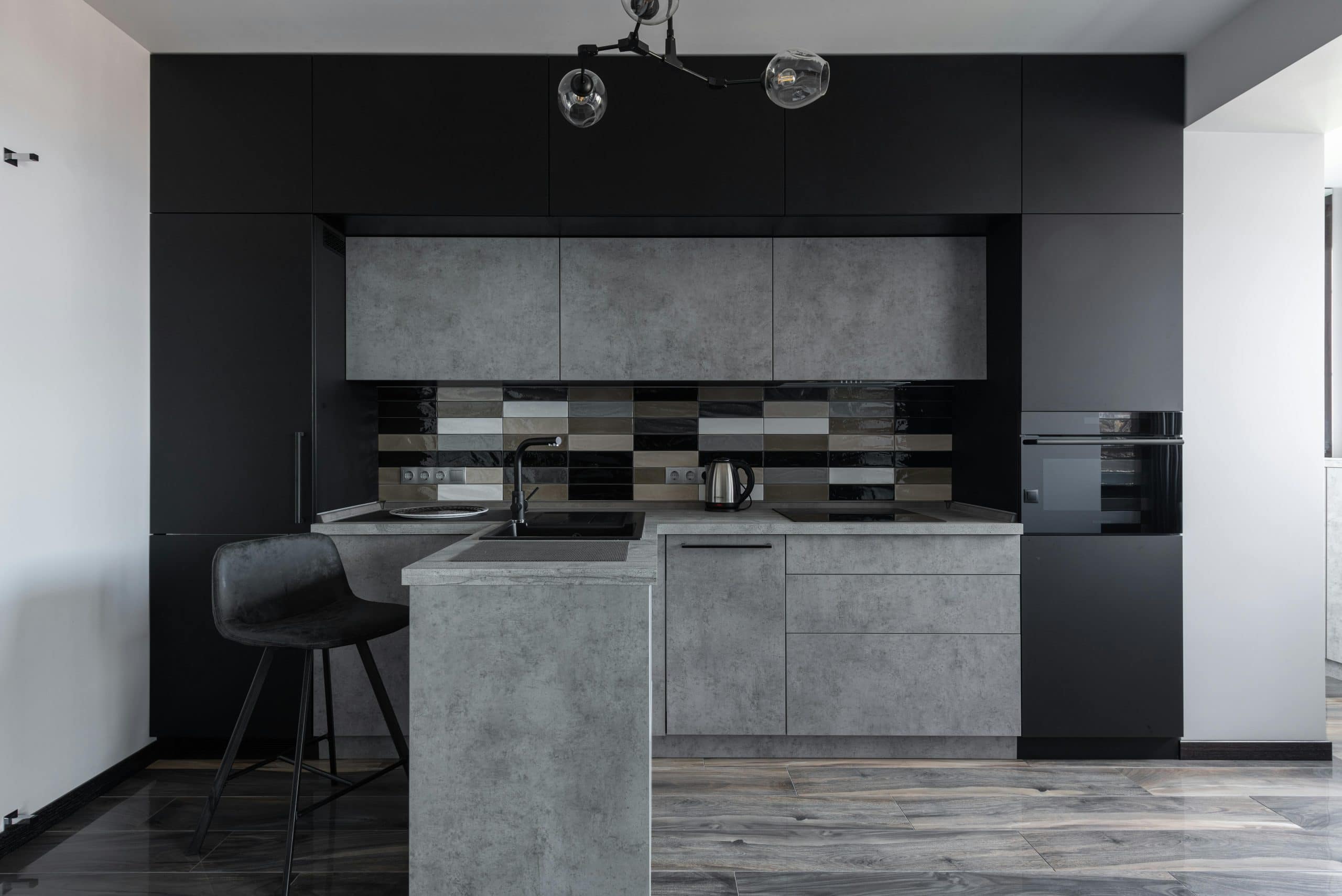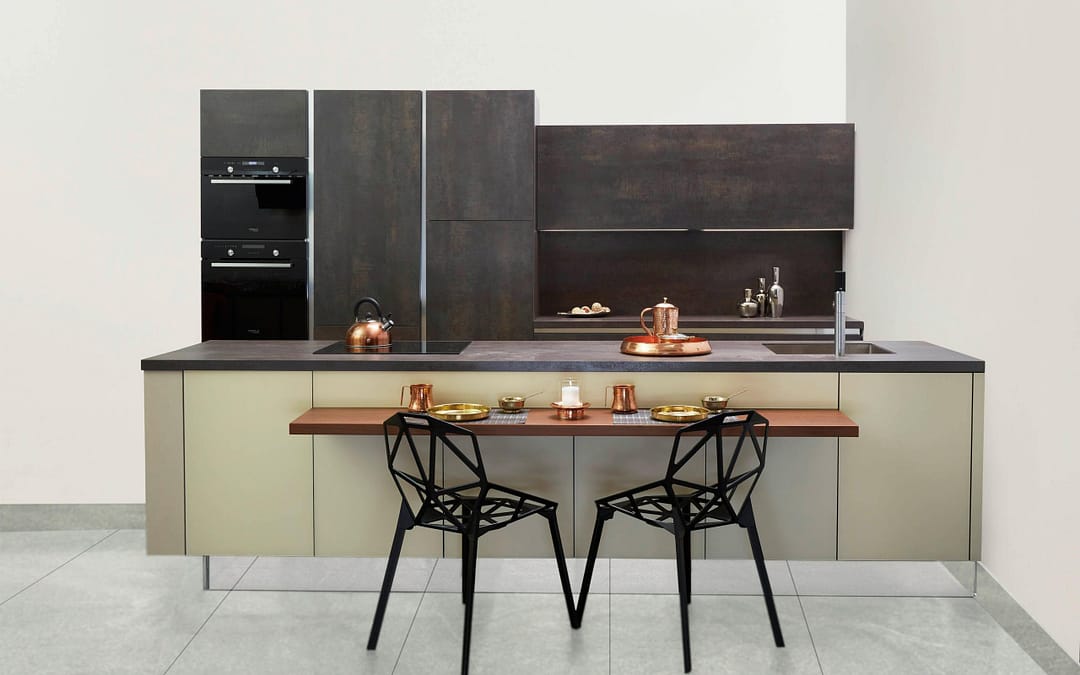Selecting premium materials is essential for creating a dreamy bespoke kitchen. The choices you make affect the room’s character and atmosphere.
Furthermore, materials affect the longevity of your renovations and the long-term value of the room. The higher the quality, the more future buyers will want to pay.
Luxury cabinets and storage solutions
Storage unit material selection matters enormously. Premium options deliver a mix of elegance, durability, and long-term value that regular options, like chipboard, don’t.
Premium kitchen cabinetry is often made of hardwood with brass fittings. Some high-end options use specialist chromoly or titanium hinge mechanisms and ceramic bearings for longer drawer life. These extras come at a premium, but are often worth the money.
Storage can also integrate with larders and kitchen islands. Additional nooks and crannies for keeping items in handy locations make the space more functional.
Surfaces: countertops and backsplashes

Surfaces are another critical consideration when it comes to bespoke kitchen materials. Correct selections can add massive value and convenience to the room.
Countertop selection
Start by reviewing your countertops. Conventional materials like laminate or raw wood are okay, but most luxury kitchen finishes demand granite, marble, soapstone and quartz.
Among these, marble is the most luxurious, but requires proper sealing. Otherwise, water and residues can seep into the rock below and damage it.
Quartz is another high-spec option that doesn’t require sealing and offers more convenience. Water rests on the surface or wipes off easily.
Granite is the hardest and heaviest. You can chop directly onto this surface, but that isn’t recommended long-term as it can still cause damage. This luxury kitchen finish pairs well with wood and other rustic elements but requires substantial physical support due to its weight.
Backsplash selection
Also, consider your backsplash and whether it meets your standards. Most high-end renovations use metal or designer tiles imported from Italy or Turkey. Metal is also an option for industrial-style kitchens, with highlight glass for more homely Shaker-style setups.
Whenever you choose luxury kitchen surfaces, select options that coordinate with your cabinetry and flooring. Ensure everything matches and makes sense.
If you can’t visualise surface options, get a designer to develop your ideas in a 3-D rendering. Check if it offers a premium or high-end look without appearing cluttered or crowded.
Fixtures and fittings
Selecting proper fixtures and fittings is also critical for luxury kitchens. These add highlights and accents that make the room special.
For example, you could:
- Add a copper or fireclay sink
- Add brushed nickel or matte black faucets
- Use brass for other items, like door handles
You can also express luxury via functionality. For example, adding a garbage disposal or a pot filler behind the stove turns a regular kitchen into a chef’s paradise.
Durable and stylish flooring
Another component of bespoke kitchens is durable flooring made of premium material. A solid surface beneath your feet inspires confidence and boosts renovation longevity.
Porcelain tiles are the most popular premium material choice for high-end kitchens. These can look sublime and give kitchens an ethereal appearance, reflecting light throughout the room. As a special type of ceramic that polishes to a high standard, porcelain is hard and also glistens, making it ideal for a bright, airy, classical or conventional kitchen.
Natural stone is another material to consider. Like other premium luxury kitchen options, it is highly durable and can withstand punishment, including items being dropped on it.
Furthermore, many homeowners like natural stone floors because they are unique. Everyone gets something organic, making the kitchen more personal.
Finally, you could consider hardwood, a slightly less common option. Nowadays, most luxury homeowners opt for engineered wood due to their enhanced strength. However, conventional oak or teak is still an option if traditional quality matters to you.
When choosing wood for your kitchen flooring, consider the following:
- Whether you want to add underfloor heating (which pairs best with stone or tile)
- The water resistance you want the floor to have
- The level of durability the floor requires
Sometimes, stone or porcelain tiles can feel harsh underfoot when you live in a part of the country that gets cold during winter. However, underfloor heating elements soon resolve this issue, allowing you to walk barefoot without getting chilly.
Statement kitchen island
Choosing high-quality materials also allows you to create statement kitchen islands. These work well as breakfast bars, preparation areas, and storage cabinets.
Many people add luxury countertops to their kitchen islands to elevate the cooking experience. Quartz, marble, and granite all work well in this setting.
You can even add metal or stone, but it should be done tastefully. Excessive brass or steel can make kitchen islands less inviting.
Additional luxury functionality to add to a kitchen island includes:
- Integrated sinks with swivel faucets
- Cooler drawers and lettuce crispers
- Waterfall edges
- Butcher blocks for preparing meat or tough vegetables
Including these elements improves aesthetics and enhances the island’s usefulness. Seating, storage, and prep space are all worthwhile additions.
Appliances and smart technology
Finally, luxury appliances and smart technology combined with premium materials should be a priority. Some manufacturers make your life easy here by integrating high-quality stainless steel into ovens and refrigerators, instantly giving them a premium finish ready for the kitchen (top options here include Miele, Wolf and Sub-Zero). You can also integrate these appliances into custom cabinetry, even if they don’t look attractive alone.
Many faucets, refrigerators and stoves now integrate with voice control, so you could explore that, too. Most manufacturers operate bespoke systems with varying levels of intelligence.
Ultimately, materials play a critical role in luxury kitchen design. Choosing the right options can create a lasting impression and ensure elements can survive the challenges of daily life.

